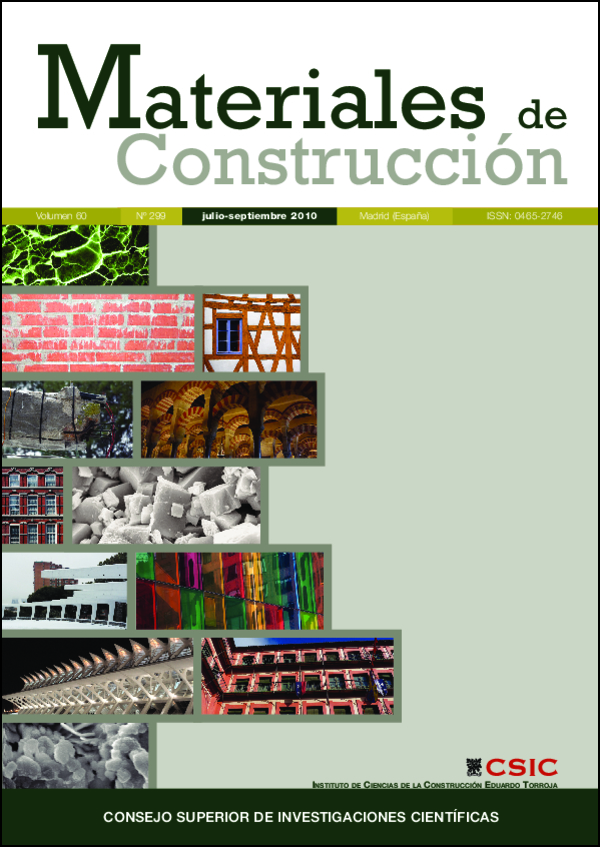Permeability and pore size distribution in medium strength self-compacting concrete
DOI:
https://doi.org/10.3989/mc.2010.50709Keywords:
self-compacting concrete, durability, microstructure, permeability, porosimetryAbstract
The use of self-compacting concrete (SCC) has been on the rise in recent years. Research on this type of concrete has focused primarily on determining optimal dosage, while durability, particularly for medium strength SCC, has received much less attention. The present study explored the permeability of a number of medium strength (characteristic strength, 30 MPa) self-compacting concretes, including SCCs made with common cement, in pursuit of a balance between performance and cost. Pressurised water and mercury intrusion porosimetry tests were conducted to determine concrete behaviour when exposed to aggressive agents. The findings showed that the capillary networks of these concretes are essentially impermeable to aggressive agents.
Downloads
References
(1) Okamura, H.: “Self Compacting High-Performance Concrete”, Concr. Int., vol. 19, nº 7 (1997), pp. 50-54.
(2) EFCA, EFNARC: The European Guidelines for Self-Compacting Concrete. Mayo 2005.
(3) ACI 237R-07: Self-Consolidating Concrete, April 2007.
(4) De Schutter, G.; Bartos; P. J.; Domone, P.; Gibbs, J.: ”Self-Compacting Concrete“, CRC Press, 296 pp., 2008.
(5) Gettu, R.; Agulló, L.: “Estado del arte del hormigón autocompactable y su caracterización (Parte I)”, Cemento y Hormigón, nº 861 (2004), pp. 50-67.
(6) Gettu, R.; Agulló, L.: “Estado del arte del hormigón autocompactable y su caracterización (Parte II)”, Cemento y Hormigón, nº 862 (2004), pp. 32-55.
(7) Assié, S.; Escadeillas, G.; Waller, V.: “Estimates of self-compacting concrete ‘potential‘ durability”, Construction and Building Materials, nº 21 (2007), pp. 1909-1917. doi:10.1016/j.conbuildmat.2006.06.034
(8) De Schutter, G.; Audenaert, K.: Durability of Self-Compacting Concrete. State of the Art Report of RILEM Technical Committee 205- DSC, RILEM, France, 2007.
(9) Boel, V.; Audenaert, K.; De Schutter, G.: “Pore distribution of hardened cement paste in self compacting concrete”, Seventh CAN-MET/ACI International Conference on Durability of Concrete, SP-234-11, 2006.
(10) Audenaert, K.; Boel, V.; De Schutter, G.: “Influence of capillary porosity on transport properties of self compacting concrete”, Eighth CANMET/ACI International Conference on Recent Advances in Concrete Technology, SP-235-1, 2006.
(11) Zhu, W.; Bartos, P. J. M.: “Permeation properties of self-compacting concrete”, Cem. Concr. Res., nº 33 (2002), pp. 921-926.
(12) Aligizaki, K. K.: Pore Structure of Cement-Based Materials, Modern Concrete Technology 12, Taylor & Francis, 2006.
(13) Ministerio de Fomento. Instrucción para la Recepción de Cementos (RC-08).
(14) Fernández Gómez, F.; Burón Maestro, M.: “Determinación de las características mecánicas de un hormigón autocompactante H-30”, Cemento y Hormigón, nº 903 (2007), pp. 52-65.
(15) Tviksta, L.: Guidelines, Report of Task 9: End Product, Rational Production and Improved Working Environment through using Self-Compacting Concrete, Brite EuRam project BRPR-CT96-0366, pp. 48.
(16) Ministerio de Fomento. Anejo 17, “Hormigón autocompactante”. Instrucción del Hormigón Estructural (EHE-08).
(17) Diamond, S.: “Mercury Porosimetry: an inappropiate method for the measurement of pore size distributions in cement-based materials”, Cem. Concr. Res., nº 30 (2000), pp. 1517-1525. doi:10.1016/S0008-8846(00)00370-7
(18) Aligizaki, K. K.: Pore structure of cement-based materials. Testing, interpretation and requirements. Abingdon. Taylor & Francis, 2006.
(19) Edel’man, L. I.; Sominskii, D. S. y Kopchikova, N. V.: “Pore size distribution in cement rocks”, Colloid Journal, 23 (2) (1961), pp. 192-196.
(20) Washburn, E. W.: “Note on a method of determining the distribution of pore size in a porous material”, Proceedings of the National Academy of Sciences, 7 (4) (1921), pp. 115-116. doi:10.1073/pnas.7.4.115
(21) Segura Pérez, I.: Tesis doctoral Caracterización del proceso de descalcificación en morteros, mediante ensayos destructivos y no destructivos, ETSI de Caminos, Canales y Puertos, Universidad Politécnica de Madrid, Madrid, 2008.
Downloads
Published
How to Cite
Issue
Section
License
Copyright (c) 2010 Consejo Superior de Investigaciones Científicas (CSIC)

This work is licensed under a Creative Commons Attribution 4.0 International License.
© CSIC. Manuscripts published in both the print and online versions of this journal are the property of the Consejo Superior de Investigaciones Científicas, and quoting this source is a requirement for any partial or full reproduction.
All contents of this electronic edition, except where otherwise noted, are distributed under a Creative Commons Attribution 4.0 International (CC BY 4.0) licence. You may read the basic information and the legal text of the licence. The indication of the CC BY 4.0 licence must be expressly stated in this way when necessary.
Self-archiving in repositories, personal webpages or similar, of any version other than the final version of the work produced by the publisher, is not allowed.
















